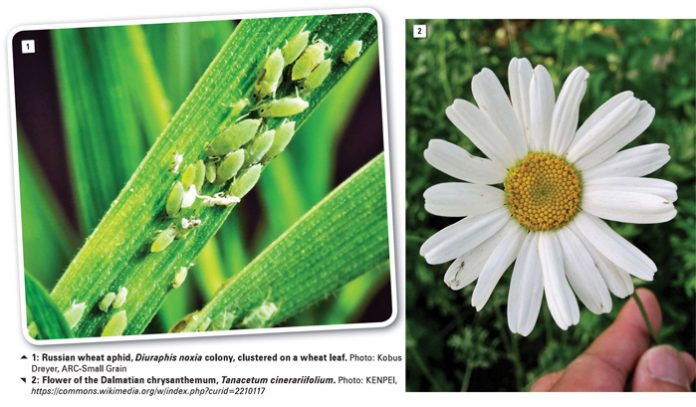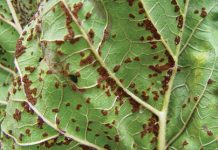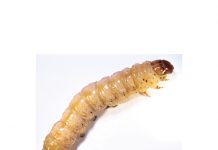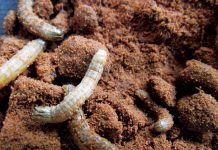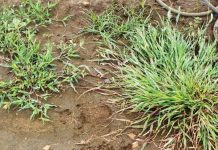September 2018
NOKULUNGA MZIMELA and DR JUSTIN HATTING, ARC-Small Grain, Bethlehem
Following the release of the first Russian wheat aphid (RWA), Diuraphis noxia (Photo 1), resistant cultivar (Tugela-DN) in 1992, host plant resistance has become the backbone of Russian wheat aphid control under dryland conditions in the summer rainfall region. However, since the arrival of the first aphid biotype, RWASA1 in 1978, three subsequent biotypes, RWASA2, RWASA3 and RWASA4, have made their unwelcome appearance.
The development of these aphid biotypes is not unexpected, as widespread deployment of host plant resistance implies evolutionary adaptation, fuelled by climate change and a higher selection pressure imposed upon the aphids by host plant resistance (i.e., survival of only those individuals that have the inherent ability to overcome the resistance).
To counteract such selection, indiscriminate mortality inflicted by natural enemies (predators, parasitoids and pathogens), is seen as a critical component in a host plant resistance x natural enemy-based control programme. Pathogens are disease-causing entities and include microbes such as fungi, viruses and bacteria; collectively referred to as entomopathogens.
As part of an integrated pest management (IPM) approach against Russian wheat aphid, ARC-Small Grain explored the combined use of host plant resistance and the insect-killing fungus (also referred to entomopathogenic fungus), Beauveria bassiana. These field trials resulted in about 65% fewer Russian wheat aphid in treated plots compared to controls.
In an attempt to further improve this level of efficacy, research was initiated on the combined use of B. bassiana with botanically based insecticides; potentially exploiting any synergy between the two biocontrol agents. Moreover, bio-insecticides are considered favourable alternatives to address chemical insecticide issues relating to human poisoning, residues, environmental pollution, insect resistance and negative effects on non-target organisms.
Notably, use of chemical pesticides may negatively affect human health and biodiversity as it is estimated that less than 0,1% of a sprayed pesticide actually reaches the target site; the rest ends up in the environment. Effective bio-insecticides can ensure a better quality of life as many employees on commercial farms are confronted by the risk of being exposed to sub-lethal doses of chemical insecticides.
During 1990, 15% of South Africa’s entire economically active workforce (1,18 million people) were working on >62 000 South African farms, while 20% of farm workers involved in chemical applications were illiterate (implying poor or non-adherence to label warnings). In fact, in 2002, around 10 000 kl’s of liquid insecticides were produced exclusively for crop protection, of which 43% consisted of highly toxic organophosphates.
Bio-insecticides of botanical origin have gained a great deal of interest, also being in direct support of organic agriculture. As pointed out in a recent review paper by Isman (2015), ‘…globally, bio-pesticides could hold close to 20% of the pesticide market by 2025 and botanicals up to 7% of the market, based on 15% to 20% annual growth in sales’ (see Pest Management Science 2015; 71:1 587 – 1 590).
An important group of botanical insecticides is the so-called pyrethrums, made from the flowers, of mainly, the Dalmatian chrysanthemum, Tanacetum cinerariifolium (Asteraceae) (Photo 2). The derived insecticide (pyrethrin) is a mixture of six active components (pyrethrins I and II, cinerins I and II, and jasmolins I and II). Pyrethrum is the main botanical in use, capturing nearly 80% of the global botanical insecticide market and has been used for insect control for over 150 years.
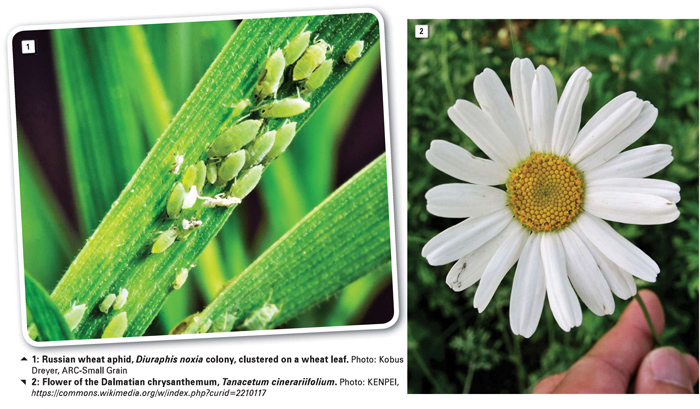
Previously, the notion of integrating entomopathogenic fungi with chemical insecticides was discussed by the same authors of this article, in the September 2015 issue of SA Graan/Grain. However, although such combinations do show potential, expanded benefits can be derived through the combination of an entomopathogenic fungus with botanicals, creating a purely organic alternative.
In the USA, the product BotaniGard® MAXX, is one such product, formulated with B. bassiana strain GHA (0,06%) combined with pyrethrins (0,75%). However, research with an indigenous strain of this fungus was needed and subsequently initiated by ARC-Small Grain as part of an MSc study by the author, Nokulunga Mzimela.
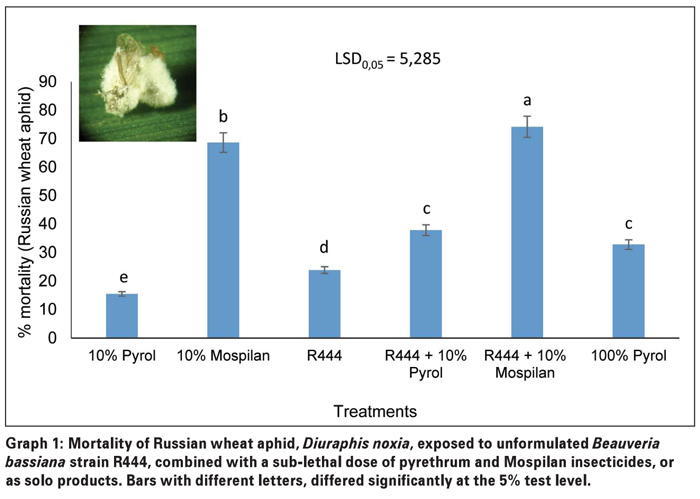 Laboratory experiments showed compatibility between B. bassiana strain R444 and various concentrations of the pyrethrum-based insecticide, PyrolTM, a certified organic insecticide registered under Act 36 of 1947 (L7062), with active ingredients: Canola oil 89,5% and pyrethrins 0,5%. Interestingly, at a reduced concentration of 10%, Pyrol increased the sporulation intensity of the fungus and the combination was then further tested against the Russian wheat aphid, together with a chemical (Mospilan®), under glasshouse conditions. Mortality results are visually presented in Graph 1.
Laboratory experiments showed compatibility between B. bassiana strain R444 and various concentrations of the pyrethrum-based insecticide, PyrolTM, a certified organic insecticide registered under Act 36 of 1947 (L7062), with active ingredients: Canola oil 89,5% and pyrethrins 0,5%. Interestingly, at a reduced concentration of 10%, Pyrol increased the sporulation intensity of the fungus and the combination was then further tested against the Russian wheat aphid, together with a chemical (Mospilan®), under glasshouse conditions. Mortality results are visually presented in Graph 1.
A synergistic effect was noted with B. bassiana R444 + 10% Pyrol, yielding a statistically similar level of control compared with the (full-dose) of Pyrol, alone. Likewise, when comparing the B. bassiana R444 + 10% Pyrol treatment to the solo 10% Pyrol treatment, efficacy was more than doubled. These results demonstrate good compatibility between the fungus and this botanical insecticide, with a clear additive effect in terms of aphid mortality.
Although so far tested only against Russian wheat aphid, such combinations may also prove effective against other aphid species like the oat aphid, Rhopalosiphum padi, an important vector of barley yellow dwarf virus in South Africa.
The notion of combining entomopathogenic fungi with a chemical or botanical insecticide as a ‘two-in-one’ tank mix, has been successfully employed against various insect pests to reduce the selection pressure brought about by the insecticide (some insects in a given population inherently resistant or less susceptible) and to avoid concurrent development of resistance in target pests.
 Other benefits relate to lower volumes of chemical insecticides applied to the environment, less (human) exposure to harmful chemicals, during and after application, and lower or no residues on harvested commodities.
Other benefits relate to lower volumes of chemical insecticides applied to the environment, less (human) exposure to harmful chemicals, during and after application, and lower or no residues on harvested commodities.
Publication: September 2018
Section: Focus on integrated pest control



